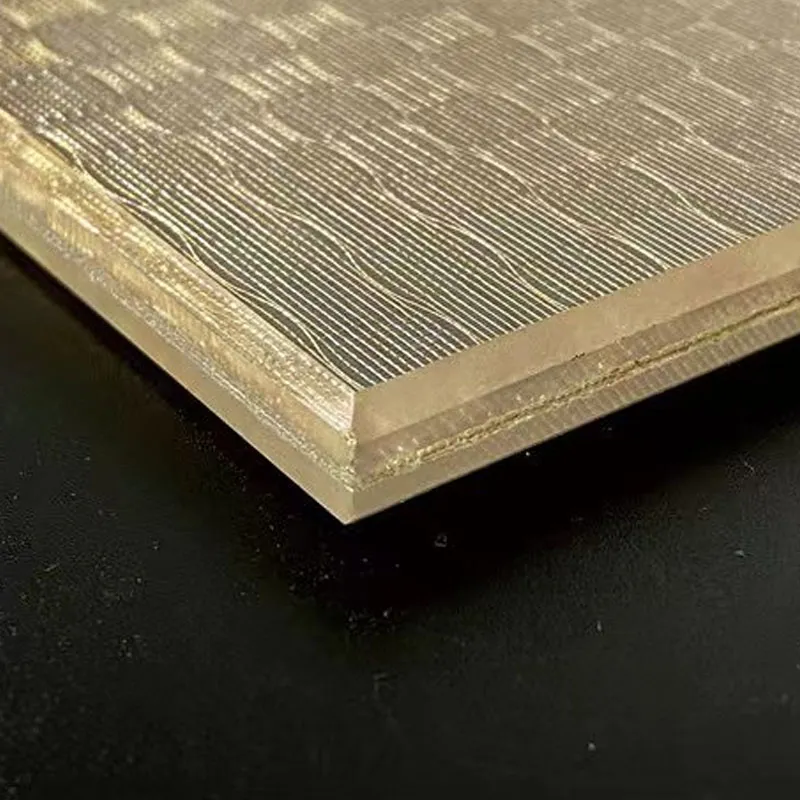The Flat Glass Manufacturing Industry An Overview
Flat glass manufacturing is an essential sector within the broader glass industry, producing a variety of glass products that are integral to modern architecture and a multitude of everyday applications. This article will delve into the processes, materials, and significance of flat glass manufacturing.
Manufacturing Processes
Flat glass is typically produced through two primary methods the float glass process and the rolled glass process.
1. Float Glass Process This method, invented in the 1950s, dominates the flat glass industry. It involves melting silica sand, soda ash, and limestone into a viscous liquid at high temperatures. The molten glass is then poured onto a bed of molten tin. The glass floats on the tin, resulting in a perfectly flat and smooth surface as it cools. This process enables the production of large sheets of glass with uniform thickness, which can then be cut into various sizes for windows, mirrors, and other applications. The float method is prized for its clarity and absence of distortions.
2. Rolled Glass Process This older method involves rolling molten glass into a flat sheet using rollers. While it allows for the production of textured glass, rolled glass is less common than float glass due to its limitations in producing large, clear sheets. It is often used for decorative purposes or in applications where distortion is not a critical factor.
Key Materials
flat glass manufacturing
The primary raw materials involved in flat glass manufacturing include silica sand, soda ash, limestone, and various chemicals that enhance properties like strength and UV resistance. The choice of materials greatly influences the glass's characteristics, including thermal efficiency, clarity, and durability. Innovations in materials, such as the incorporation of recycled glass, play a crucial role in improving sustainability within the industry.
Environmental Considerations
The flat glass manufacturing sector has made significant strides in sustainability. The production process is energy-intensive, but advancements in technology have improved energy efficiency. Many manufacturers are adopting practices like recycling waste glass, also known as cullet, which reduces the need for raw materials and energy. This not only lowers manufacturing costs but also minimizes environmental impact.
Additionally, the rise of energy-efficient buildings has driven demand for specialized flat glass products, such as low-emissivity (Low-E) glass, which reflects infrared radiation while allowing visible light to pass through. This technology contributes to energy conservation in buildings by reducing heating and cooling costs.
Market Trends
The flat glass market is experiencing growth due to several factors, including urbanization, increasing construction activities, and a growing focus on renewable energy sources. The rise of solar energy has spurred demand for flat glass in photovoltaic applications, where glass is used to cover solar panels, enhancing both functionality and aesthetics.
In conclusion, the flat glass manufacturing industry plays a critical role in modern society, offering a wide range of products integral to architecture, automotive, and energy sectors. As the industry continues to evolve, it must balance the demands for high-quality products with the need for sustainable practices, ensuring it contributes positively to both the economy and the environment. With ongoing innovations and a commitment to eco-friendly production, the flat glass industry is poised for a bright future.
 Afrikaans
Afrikaans  Albanian
Albanian  Amharic
Amharic  Arabic
Arabic  Armenian
Armenian  Azerbaijani
Azerbaijani  Basque
Basque  Belarusian
Belarusian  Bengali
Bengali  Bosnian
Bosnian  Bulgarian
Bulgarian  Catalan
Catalan  Cebuano
Cebuano  Corsican
Corsican  Croatian
Croatian  Czech
Czech  Danish
Danish  Dutch
Dutch  English
English  Esperanto
Esperanto  Estonian
Estonian  Finnish
Finnish  French
French  Frisian
Frisian  Galician
Galician  Georgian
Georgian  German
German  Greek
Greek  Gujarati
Gujarati  Haitian Creole
Haitian Creole  hausa
hausa  hawaiian
hawaiian  Hebrew
Hebrew  Hindi
Hindi  Miao
Miao  Hungarian
Hungarian  Icelandic
Icelandic  igbo
igbo  Indonesian
Indonesian  irish
irish  Italian
Italian  Japanese
Japanese  Javanese
Javanese  Kannada
Kannada  kazakh
kazakh  Khmer
Khmer  Rwandese
Rwandese  Korean
Korean  Kurdish
Kurdish  Kyrgyz
Kyrgyz  Lao
Lao  Latin
Latin  Latvian
Latvian  Lithuanian
Lithuanian  Luxembourgish
Luxembourgish  Macedonian
Macedonian  Malgashi
Malgashi  Malay
Malay  Malayalam
Malayalam  Maltese
Maltese  Maori
Maori  Marathi
Marathi  Mongolian
Mongolian  Myanmar
Myanmar  Nepali
Nepali  Norwegian
Norwegian  Norwegian
Norwegian  Occitan
Occitan  Pashto
Pashto  Persian
Persian  Polish
Polish  Portuguese
Portuguese  Punjabi
Punjabi  Romanian
Romanian  Russian
Russian  Samoan
Samoan  Scottish Gaelic
Scottish Gaelic  Serbian
Serbian  Sesotho
Sesotho  Shona
Shona  Sindhi
Sindhi  Sinhala
Sinhala  Slovak
Slovak  Slovenian
Slovenian  Somali
Somali  Spanish
Spanish  Sundanese
Sundanese  Swahili
Swahili  Swedish
Swedish  Tagalog
Tagalog  Tajik
Tajik  Tamil
Tamil  Tatar
Tatar  Telugu
Telugu  Thai
Thai  Turkish
Turkish  Turkmen
Turkmen  Ukrainian
Ukrainian  Urdu
Urdu  Uighur
Uighur  Uzbek
Uzbek  Vietnamese
Vietnamese  Welsh
Welsh  Bantu
Bantu  Yiddish
Yiddish  Yoruba
Yoruba  Zulu
Zulu 

